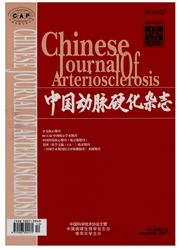

 中文摘要:
中文摘要:
目的探讨厄贝沙坦对载脂蛋白E基因敲除小鼠动脉粥样硬化斑块的影响及炎症机制。方法载脂蛋白E基因敲除小鼠随机分为普食组、高胆固醇饮食组、高胆固醇饮食+厄贝沙坦组,每组15只,分别予蒸馏水、蒸馏水、厄贝沙坦10mg/(kg·d)灌胃12周。无创血压系统测小鼠血压;内眦动脉取血检测血清总胆固醇和甘油三酯水平;冰冻切片光镜下定位主动眯根部,油红O染色评估斑块大小;实时定量聚合酶链反应和Westemblotting方法检测主动脉肿瘤坏死因子α、白细胞介素6、单核细胞趋化蛋白1和血管细胞粘附分子1的表达。结果高胆固醇饮食组小鼠血脂水平明显升高(P〈0.01),且斑块面积明显高于普食组(P〈0.01);厄贝沙坦明显减小斑块面积(P〈0.01),同时降低肿瘤坏死因子α、白细胞介素6、单核细胞趋化蛋白1和血管细胞粘附分子1的表达(P〈0.01)。结论血管紧张素Ⅱl型受体拮抗荆厄贝沙坦可以通过降低炎症因子的表达,从而达到抑制动脉粥样硬化发生发展的目的。
 英文摘要:
英文摘要:
Adult male ApoE KO mice were given normal diet or high cholesterol-diet and randomized to no treatment or irbesartan 10 mg/( kg· d) for 12 weeks. Systolic blood pressure was measured by a kind of non-invasive tail cuff system in conscious mice. The plasma total cholesterol and triglyceride concentration were measttred by autoanalyzer. Atlierosclerotic lesion area in aortic root was evaluated by oil red O staining, hdlammatory cytokines were measured by real-time reverse-transcription polymerase chain reaction (PCR) and Western blotting. Results The ApoE KO mice with high cholesterol-diet was associated with a marked increase in plasma lipid levels, atherosclerotic lesion area, as well as the expressions of tumor necrosis factor-α (TNF-α), interleukin-6 ( IL-6 ), monocyte ehemoattactant pmtein- 1 ( MCP- 1 ) and vascular cell adhesion molecule- 1 ( VCAM- 1 ). These changes were suppressed in mice that were treated with irhesartan 10 mg/(kg· d) for 12 weeks concomitant with high cholesteroldiet adinildstmtion, with no significant change in systolic blood pressure and plasma lipid levels. Conclusion The results suggest that irbesartan can attenuate atherosclerosis, and this effect is partly related to the inhibition of inflammatory response which leads to the decrease in the expression of inflammatory cytokines.
 同期刊论文项目
同期刊论文项目
 同项目期刊论文
同项目期刊论文
 Relationship between plasma inflammatory markers and plaque fibrous cap thickness determined by intr
Relationship between plasma inflammatory markers and plaque fibrous cap thickness determined by intr 期刊信息
期刊信息
